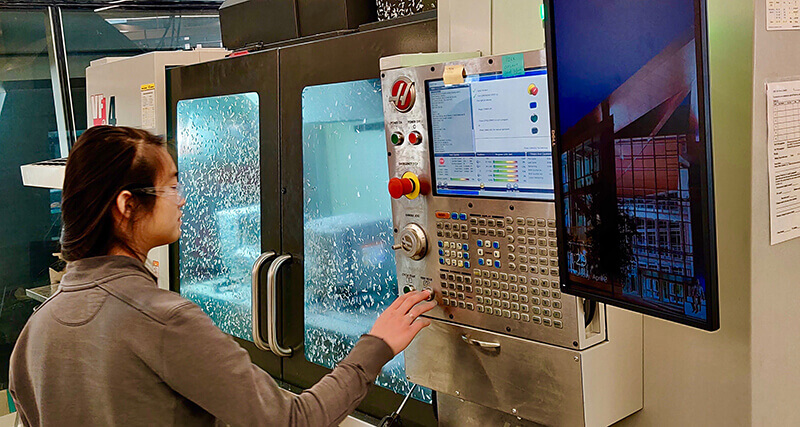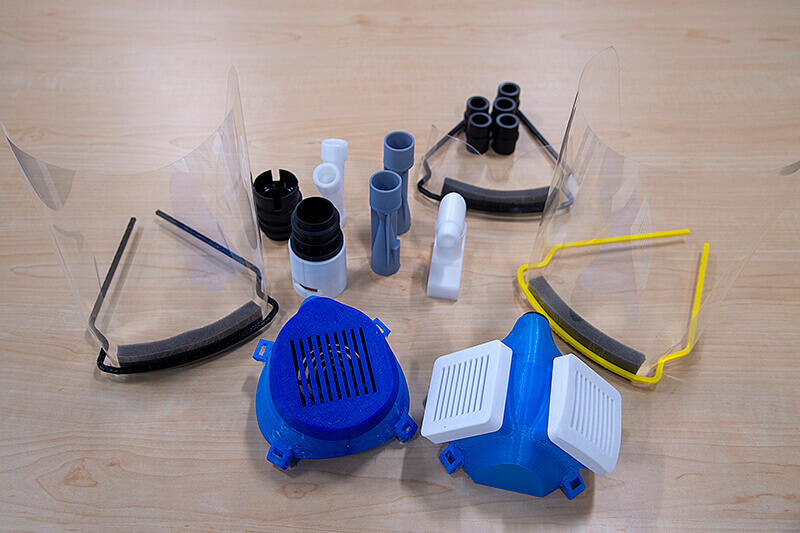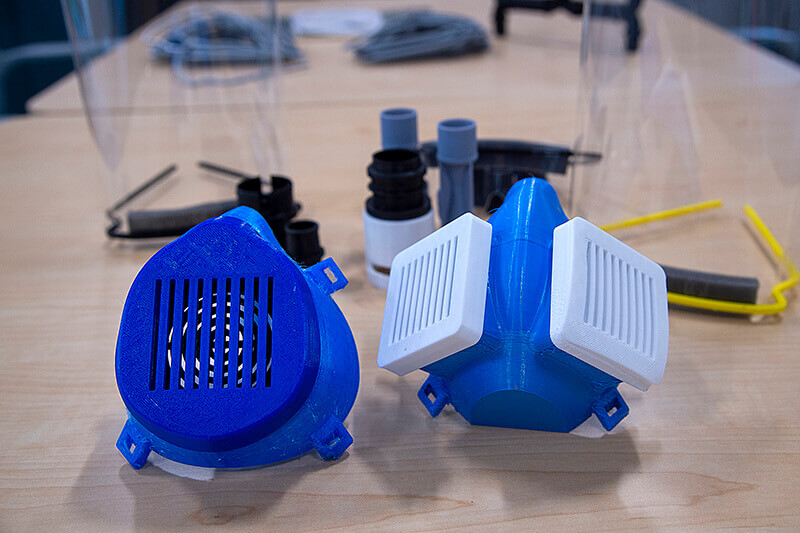April 6, 2020
Boiler 'Maker' team begins producing medical supplies

Purdue University staff and graduate students in the Bechtel Innovation Design Center are using equipment such as 3D printers to produce medical supplies for hospitals. Frames for safety glasses and face shields have been produced and will be delivered this week.
Items produced in Purdue manufacturing facilities will be sent to hospitals in Indiana
WEST LAFAYETTE, Ind. — The Purdue University community has such a reputation for being makers that the word is literally a part of the team name, the Boilermakers. Now a group at the university has organized to produce much-needed medical supplies for Indiana hospitals.
And being Purdue engineers and technologists, they couldn't get involved without finding a few ways to improve the products, too.
The medical supplies — safety glasses and face shields at first — are expected to be delivered to hospitals in Indiana this week.
 Purdue University faculty and staff have begun producing medical supplies to deliver to hospitals in Indiana. Using test-bed manufacturing facilities at the university, they have produced safety glasses, face shields, disposable connectors for ventilators, and N95 masks that can be easily disinfected. (Purdue University image/Mark Simons)
Download image
Purdue University faculty and staff have begun producing medical supplies to deliver to hospitals in Indiana. Using test-bed manufacturing facilities at the university, they have produced safety glasses, face shields, disposable connectors for ventilators, and N95 masks that can be easily disinfected. (Purdue University image/Mark Simons)
Download image
The Purdue faculty and staff members are working closely with physicians and staff at IU Health, IU School of Medicine and Franciscan Health to develop plans for the supplies. Facilitated through an arrangement between county health officials and the Purdue University Fire Department under Indiana’s mutual aid program, Purdue is partnering with these institutions to augment their supplies of glasses, face masks, N95 respirators, and disposable fittings for ventilators.
The volunteer Makers group has approximately 40 faculty and staff members participating, representing Purdue Polytechnic Institute, the College of Engineering, the College of Pharmacy and the School of Nursing, as well as Birck Nanotechnology Center, Ray W. Herrick Laboratories, the Bechtel Innovation Design Center and the Envision Center for Data Perceptualization.
Nathan Hartman, Purdue's Dauch Family Professor of Advanced Manufacturing and head of the Department of Computer Graphics Technology, as well as co-executive director of the Indiana Manufacturing Competitiveness Center (IN-MaC), is leading the effort.
"Getting this done has been a lesson in persistence," Hartman said. "Two weeks ago, when a few people began sending each other emails about discussing this, it seemed like it wouldn't be possible. But people kept getting involved and offering their expertise and equipment, and within a week we began working on a plan, and now we have produced useful PPE for the health care community."
Because Purdue conducts research and teaches a variety of classes in manufacturing, technology and engineering, the university has several small manufacturing facilities. Capabilities include injection molding, vacuum forming, roll-to-roll manufacturing, machining, 3D printing, laser scanning and assembly operations.
 Engineers at Purdue University have designed an N95 face mask that can easily be disinfected and uses filters commonly found in hospitals in devices such as ventilators. The university is producing the masks in its test-bed manufacturing facilities. (Purdue University image/Mark Simons)
Download image
Engineers at Purdue University have designed an N95 face mask that can easily be disinfected and uses filters commonly found in hospitals in devices such as ventilators. The university is producing the masks in its test-bed manufacturing facilities. (Purdue University image/Mark Simons)
Download image
"We'll be putting out more information about this as more of the details are worked out. It's a fast-moving situation, but our faculty and staff are working together to do as much as they can for the people of our state," Hartman said. "We realized we had the expertise and the capacity to help, so why wouldn’t we?"
Purdue will be centrally supporting the material and items needed to support the Maker effort, until such time as resources become available for the state and federal stimulus funds to reimburse the university for these efforts.
"The Purdue administration has been incredible in supporting our efforts, handling the purchasing, legal issues, communications, and facilities issues. They've supported us every step of the way," Hartman said.
Purdue's Bechtel Innovation Design Center is a student "makerspace" or prototyping facility. Although closed to students at this time, it has a variety of tools that have been put to use in this effort, said David McMillan, assistant director of the center.
"The Bechtel Innovation Design Center staff and students were searching for the right opportunity to apply our expertise in design and rapid prototyping," McMillan said. "Under guidance from medical professionals, we have redesigned and manufactured complex fittings for ventilators and are actively producing laser cut, waterjet cut, and 3D-printed parts for face shields and safety glasses."
Purdue's Birck Nanotechnology Center is at work producing lenses for protective glasses and face shields in the center's pilot-scale manufacturing facility. Currently the facility's roll-to-roll laser cutting system has produced 1,600 lenses and 2,500 face shields, and is expected to eventually produce 3,000 lenses and 4,000 face shields.
Miko Cakmak, Purdue's Reilly Professor of Materials and Mechanical Engineering, is overseeing the work in Birck.
"A number of additional Birck staff members volunteered to work on this project to rapidly scale up our production," Cakmak said. "The work is being carried out by staff scientists Guy Telesnicki and Nick Glassmaker."
The raw materials for the face shields and lenses were donated by Eastman Chemical.
"This company has been very helpful to us in this effort," Cakmak said.
The Maker team also is working to develop an improved design for N95 respirators using injection molding.
"The respirator uses filters that are commonly found in hospitals in ventilators and other devices, so these are easy to find and are easy to replace. The rest of the respirator can be easily and quickly disinfected," Hartman said.
Hartman also notes that he and other faculty members have been receiving many inquiries from people with home 3D printing machines, and says this is often not a good idea.
"I completely understand their desire to help during a crisis. Although it is possible for individuals to model and print respirator masks or other PPE using plans they find online, they should exercise high levels of caution," Hartman says. "The printers use a filament as the raw material, and as it is laid down this material leaves microscopic gaps in the finished product that can harbor the virus and are impossible to disinfect."
"The reality is that hobbyists really can't produce these materials effectively given the complexities of materials and processes."
About Purdue University
Purdue University is a top public research institution developing practical solutions to today’s toughest challenges. Ranked the No. 6 Most Innovative University in the United States by U.S. News & World Report, Purdue delivers world-changing research and out-of-this-world discovery. Committed to hands-on and online, real-world learning, Purdue offers a transformative education to all. Committed to affordability and accessibility, Purdue has frozen tuition and most fees at 2012-13 levels, enabling more students than ever to graduate debt-free. See how Purdue never stops in the persistent pursuit of the next giant leap at purdue.edu.
Media contact to arrange interviews: Steve Tally, 765-494-9809, steve@purdue.edu, @sciencewriter
Sources: Nathan Hartman
David McMillan
Note to Journalists: B-roll of materials being produced is available from Steve Tally, steve@purdue.edu.

